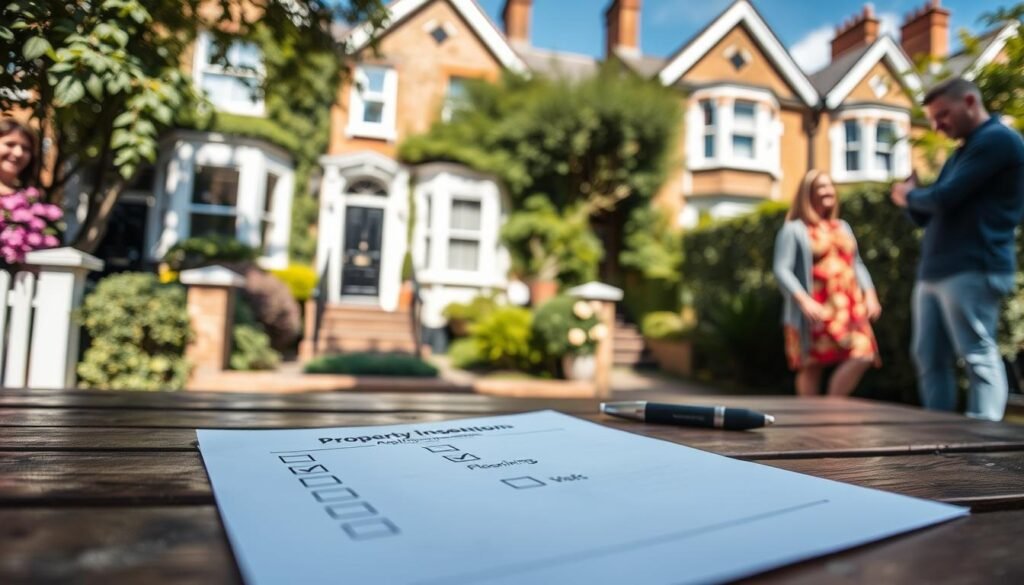Ever wondered when normal wear and tear turns into tenant-caused damage? As a landlord, knowing your rights and duties about property damage is key. This guide will help you understand tenant responsibility and rental agreement terms.
Renting out a property has its challenges. Most tenants are good, but some damage is unavoidable. But what if damage goes too far? Can you ask tenants to pay for repairs, and how much? Let’s explore landlord rights and the costs of property damage.
Key Takeaways
- Landlords can charge for damages beyond normal wear and tear
- Charges must be fair and related to actual damage caused
- Documentation and evidence are crucial for successful claims
- Security deposits are protected by government-backed schemes
- Regular inspections can help minimise damage risks
- Clear tenancy agreement terms can prevent disputes
- Small claims court is an option for uncovered costs
Understanding Tenant Damage and Wear and Tear
As a landlord, knowing the difference between wear and tear and tenant damage is vital. This knowledge helps you manage costs and understand who is liable for negligence.
What Constitutes Wear and Tear
Fair wear and tear is the natural wear of a property over time. This includes:
- Faded paint or wallpaper
- Worn carpets in high-traffic areas
- Minor scuffs on walls or floors
- Slight discolouration of curtains
These changes are expected and can’t be charged to tenants. The definition of fair wear and tear depends on the tenancy length and property type.
What Constitutes Tenant Damage
Tenant damage is more than just normal use. It often results from negligence or accidents. Examples include:
- Stains on carpets or upholstery
- Holes in walls
- Broken windows or appliances
- Pet-related damage
In these cases, the tenant is liable for negligence. You may deduct repair costs from the deposit.
| Wear and Tear | Tenant Damage |
|---|---|
| Faded curtains | Torn or stained curtains |
| Worn carpet | Burns or cuts in carpet |
| Minor scuffs on walls | Large holes or unauthorized paint |
| Loose door handles | Broken locks or doors |

Remember, clear documentation and fair assessments are key. They help manage your rental property well and avoid disputes over damages.
Importance of Documentation and Evidence
Keeping detailed records is key when dealing with damages caused by tenants. As a landlord, you must protect your interests. This ensures fair treatment for everyone involved.
Begin with a thorough property inspection before the tenant moves in. Make a detailed inventory list, including photos and videos. This will be your baseline for comparison when the tenancy ends.
Regular inspections during the tenancy help spot issues early. Keep records of all communication about property maintenance or damage. This evidence is crucial if disputes arise later.

When the tenant leaves, do another detailed inspection. Compare the property’s condition to your initial records. Document any changes that aren’t just normal wear and tear. This will support your case if you need to deduct from the deposit.
| Documentation Type | Purpose | Frequency |
|---|---|---|
| Initial Inventory | Establish property condition | Before tenancy starts |
| Regular Inspections | Monitor property condition | Every 3-6 months |
| Communication Records | Track reported issues | Ongoing |
| Final Inspection | Assess tenant-caused damages | At tenancy end |
Clear and detailed documentation is your strongest defence in disputes. It protects both you and your tenant. This ensures a fair outcome if issues come up.
Fair and Reasonable Charges for Tenant Damage
Landlords must ensure tenant damage charges are fair and justified. Repair costs should only cover actual damage, not normal wear and tear. It’s important to give tenants itemised deductions, showing what they’re charged for.
Like-for-Like Replacements
Landlords can only charge for exact replacements of damaged items. You can’t upgrade at the tenant’s expense. For example, if a carpet is stained, you can’t charge for new carpeting everywhere.
Charges should be based on the item’s age, condition, and expected lifespan.
No Upgrades at Tenant’s Expense
It’s important to avoid ‘betterment’ when assessing damage costs. You’re not entitled to be financially better off after a tenancy ends. If a five-year-old sofa is damaged, you can’t charge for a brand new one.
Instead, calculate the remaining value based on its expected lifespan.
| Item | Expected Lifespan | Charge Calculation |
|---|---|---|
| Carpet | 7-10 years | Replacement cost ÷ Expected lifespan × Remaining years |
| Sofa | 7-15 years | Replacement cost – (Age × Annual depreciation) |
| Paint | 2-3 years | Full cost if damaged before expected repaint |
Remember, clear documentation and evidence are vital when charging for damages. Always provide tenants with detailed, itemised deductions. This helps avoid disputes and ensures a fair process for all.
Handling Deposit Deductions for Damages
Landlords face a complex set of rules when dealing with security deposits. In the UK, deposits must be protected in government-backed schemes within 30 days. This makes the process fair for both sides.
Government-Backed Deposit Schemes
Deposit protection schemes keep tenants’ money safe. They also help solve disputes. There are two main types:
- Custodial schemes: The scheme holds the deposit
- Insurance-based schemes: The landlord keeps the deposit but pays insurance
Dispute Resolution Processes
If there’s a disagreement over deposit deductions, independent adjudicators help. They aim to be fair and unbiased. Landlords can’t just use deposits for damages without agreement or adjudication.
Common reasons for deductions include:
| Reason | Frequency |
|---|---|
| Cleaning | Most common |
| Damaged/missing items | Common |
| Redecoration | Common |
| Gardening | Common |
| Rent arrears | Can be claimed |
| Unpaid utility bills | Can be claimed if in landlord’s name |
To improve your chances in disputes, keep detailed records. Include signed inventories, check-in/out reports, and dated photos. Remember, wear and tear is important when judging damages.
Can You Charge A Tenant For Damages?
Yes, you can charge a tenant for damages. The Landlord and Tenant Act 1985 says tenants must fix any damage they cause. But, they’re not responsible for normal wear and tear, which is the landlord’s job.
For tenant responsibility for repairs, keeping records is key. Document the property’s state before and after the tenancy. This proof is vital for landlord claims for property damage.
If repair costs are more than the deposit, you have legal options. You can take the case to small claims court for amounts under £3,000. The court can make tenants pay within 28 days.
When taking money from a tenant’s deposit, give them a detailed list of damages and costs. Include receipts or estimates to back up your claims.
In serious cases, you can evict tenants for major damage. You might use a section 8 notice for specific breaches or a section 21 notice for no-fault evictions.
To protect yourself, think about getting landlord insurance. Standard residential insurance often doesn’t cover rented properties. Landlord contents insurance can protect your furniture and appliances from tenant damage.
Tenant Damage and Neighbouring Properties
When you rent a place, you’re not just looking after your own space. You also have to think about the property next door. This includes things like water damage from baths, broken windows, or damaged fences.
As a tenant, you’re responsible for any damage caused by you, your guests, or anyone living with you. If damage happens, you must tell the landlord and fix it quickly. If you don’t, you might lose some of your deposit or face legal trouble.
If your neighbour’s property gets damaged because of you, they might ask their insurance to cover it. This could lead to arguments and even eviction. This can be expensive and time-wasting for landlords.
- Report accidental damages immediately
- Repair any damage before your tenancy ends
- Be aware of your liability for neighbouring property damage
To protect yourself, think about getting contents insurance. It can help cover damages to your belongings in the rented place. Remember, while landlords have insurance for the building, they won’t pay for your personal items if they’re damaged by crime.
Knowing your duties about rental property damage is key. It keeps good relations with neighbours and landlords. It also helps you avoid unexpected costs or legal problems.
Minimising Tenant Damage Risk
Keeping your rental property safe from damage is key for landlords. With malicious damage claims up by 37% from 2015 to 2020, it’s vital to act early. Let’s look at ways to lower the risk of tenant damage and keep your property’s value high.
Practical Property Decorations and Furnishings
Go for neutral, tough decor and furniture in your rental. Pick durable appliances and use things like mattress covers and strong doormats. These steps can greatly cut down on wear and tear, making upkeep simpler and cheaper.
Clear Tenancy Agreement Terms
Your lease should clearly state what tenants must do. Make sure it covers how to care for the property and what to do if there’s damage. Be clear about what’s fair wear and tear versus damage caused by tenants. This helps avoid arguments and makes sure tenants know their duties.
| Recommended Measures | Benefits |
|---|---|
| Four-point tenant reference check | Reduces risk of problematic tenants |
| Regular six-monthly inspections | Early identification of potential issues |
| Detailed property inventory | Clear record of property condition |
| Deposit protection schemes | Secure handling of tenant deposits |
By using these methods, you can greatly lower the chance of tenant damage. This ensures smoother tenancies. Always remember, it’s better to prevent problems than fix them later when it comes to looking after your rental property.
Accidental Damage vs. Tenant Negligence
It’s key for landlords and tenants to know the difference between accidental damage and tenant negligence. This is important for figuring out who is responsible and how to deal with damage claims.
Accidental damage happens by mistake, without anyone meaning to cause harm. For example, if a tenant accidentally breaks a vase, they might not be fully responsible. This is especially true if they looked after the property well.
Negligence, however, is when someone doesn’t take proper care. If a tenant ignores a leaky pipe and it causes water damage, they are at fault. In these cases, the tenant must pay for the damage.
It’s also important to remember that normal wear and tear is not the same as damage caused by accidents or negligence. Wear and tear is just part of the property getting older and is the landlord’s job to deal with.
| Type of Damage | Description | Responsibility |
|---|---|---|
| Accidental | Unexpected, unintentional incidents | May be shared or covered by insurance |
| Negligence | Failure to exercise proper care | Typically tenant’s responsibility |
| Wear and Tear | Natural deterioration over time | Landlord’s responsibility |
Landlords should think about getting comprehensive landlord insurance. This can cover different types of damage, like accidents to the building or fixtures. Tenants might also want to consider getting insurance for their own belongings and any liability they might have.
Dealing with Damage After Tenancy Ends
When your tenancy ends, it’s key to do move-out inspections. These checks find any damage not caused by normal wear and tear. If you spot problems, you might need to claim back your security deposit.
Assessing Damage and Costs
Compare the property’s current state to its start condition during inspections. Take photos and notes for evidence. This helps tell the difference between acceptable wear and tear and damage you can charge for.
If the damage costs more than the deposit, you might go to small claims court. Remember, you can only charge for actual costs, not for upgrades. Keep all receipts and quotes as proof.
Small Claims Court for Uncovered Costs
When damages are more than the deposit, small claims court could be next. Here’s what you need to know:
- Gather all evidence documentation, including photos, receipts, and tenancy agreements
- Ensure your charges are fair and reasonable
- Be prepared to show that the damage isn’t normal wear and tear
- File your claim within the legal time limits
Remember, you have ten days from the tenant’s deposit return request to suggest deductions for damages. Always try to find a fair solution before going to court.
| Item | Wear and Tear | Chargeable Damage |
|---|---|---|
| Carpet | Fading, light wear | Stains, burns, tears |
| Walls | Minor scuffs | Large holes, unauthorised paint |
| Appliances | Normal usage marks | Broken parts, misuse |
Preventative Measures and Regular Inspections
Keeping your rental property safe needs proactive steps. Regular checks are vital to keep your property in good shape and avoid expensive repairs. Knowing your duties in property upkeep is essential for managing your property well.
Doing inspections every three months is a good idea to spot problems early. Always give notice and get your tenant’s okay before you go. This follows the law and keeps your relationship with your tenant strong.
Ask your tenants to tell you about any problems right away. Talking openly can stop small issues from getting bigger. Make sure your rental agreement has clear rules for reporting problems.
| Inspection Frequency | Benefits | Legal Considerations |
|---|---|---|
| Quarterly | Early issue detection | Tenant notice required |
| Bi-annually | Less intrusive for tenants | Align with tenancy agreement |
| Annually | Comprehensive property review | Document all findings |
Think about hiring a professional property manager. They can do thorough checks and keep up with the law. This can also lower the chance of damage to your property.
Conclusion
Understanding tenant rights and obligations is key when dealing with property damage disputes. As a landlord, it’s important to know the difference between normal wear and actual damage. More people living in a property means more wear and tear in shared areas.
Rental laws, like Section 11 of the Landlord and Tenant Act 1985, explain who is responsible for repairs. Tenants must fix any damage they or their guests cause. When deciding who is at fault, think about the item’s original cost, quality, and age at the start of the tenancy.
If disagreements happen, tenant deposit schemes can help make a final decision. To protect yourself, keep detailed records, do regular checks, and think about getting landlord insurance for malicious damage. Good communication and following the law can help solve property damage issues and keep good relations with tenants.




